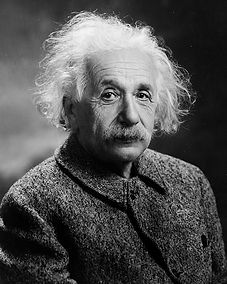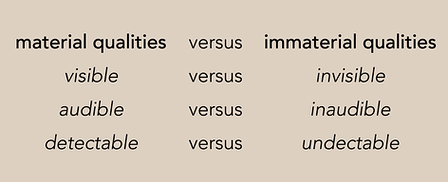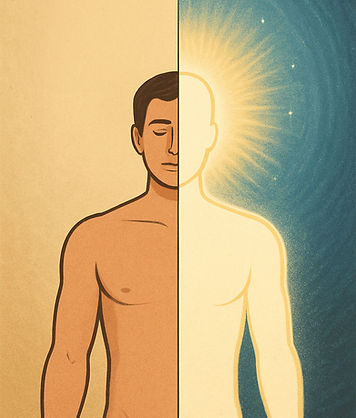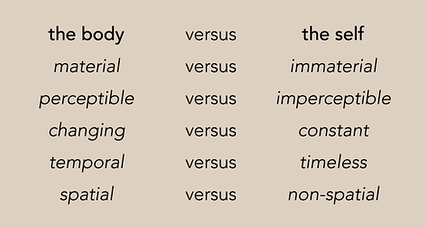
Abbreviated Version
Paired Qualities. When we look what do we see? When we listen what do we hear? When we touch what do we feel? The answer to each of these questions is qualities. We see the qualities light versus dark. We hear the qualities loud versus soft. We feel the qualities rough versus smooth.
Qualities are changing as we perceive them. As they change they become different. A quality that has become different is the contrary of what it was before it changed. When the quality cold changes it becomes the quality hot. Because the qualities hot and cold are changing an object characterized by them is neither absolutely hot nor absolutely cold. Instead, the quality hot is changing to become the quality cold and the quality cold is changing to become the quality hot.
We perceive the quality hot and the quality cold in opposition to each other in a kind of tug-of-war relationship. Neither quality wins out because both qualities are changing. The war is continuous. The relationship of the two qualities is in flux, but because it continues indefinitely the qualities are paired. Theirs is a two-in-one relationship: two qualities make one pair.

Standalone Ideas. With our senses we perceive qualities that are changing, relative, and paired. With our mind we conceive ideas of entities that are constant, absolute, and separate. We perceive qualities “out there” in the world. We conceive ideas “In here” in our mind.
The qualities we perceive are always characteristics of ideas we conceive. We never perceive qualities that are separate from entities. When we speak of the quality hot, for example, we refer to something that is hot. When we refer to something, we identify it by the qualities that characterize it. We differentiate one entity from another by noting the difference in their respective qualities. A quality is meaningful as it characterizes an entity. An entity is meaningful as it is characterized by qualities. Entities are identifiable only as they are characterized by qualities. Qualities are perceived only as they characterize entities.
Even though qualities are perceived out there and ideas of entities are conceived in here, because qualities are perceptible while ideas are imperceptible, we believe that entities exist out there where we perceive their qualities. When I view my table, for example, I consider it to be out there apart from me even though I conceive the idea of it in here in my mind.
There are constant ideas that are not characterized by qualities. We refer to them as “abstract ideas” because they have no identifiable characteristics. We have no conscious awareness of the existence of entities that are not characterized by perceived qualities. To enable an abstract idea of an entity to be considered in a context we associate it with an institutional belief system. The idea of the “universe,” for example, though abstract because it has no perceived qualities that characterize it, is nonetheless believed to be meaningful in the context of the physical sciences. Monotheistic religion provides meaning for the otherwise abstract idea of “God.” The term “zero” is abstract yet meaningful in the context of mathematics. Music theory provides meaning for the abstract idea of “tonality.” In each of these cases meaning isn’t the result of qualities that characterize an entity but is rather associated with abstract ideas in the context of a belief system. Our conscious awareness of abstract ideas is limited to their relationship to institutional beliefs.
Just as we are able to conceive ideas of entities so too are we able to conceive ideas of qualities. We perceive qualities out there in the world. We conceive ideas of qualities in here in our mind. The qualities we perceive are changing. The qualities we conceive are constant. Because perceived qualities are changing, we perceive them in paired relationships. Because conceived qualities are constant, we conceive them as separate from each other. A perceived quality is relative because it is perceived in relation to its partner quality. A conceived quality is absolute because it is conceived separately from other qualities.
A general rule concerning perceived qualities is that they are out there, changing, paired, and relative. A similar rule regarding conceived qualities is that they are in here, constant, separate, and absolute.

Matter and Energy. Christians of the Middle Ages (about 500 to 1500 CE) believed in God as the creator of the world and that a spirit or soul is the animating or vital substance that sustains human life. As immaterial, constant, non-spatial, eternal, and infinite, God, though invisible, was believed to be everywhere present. Although not detectable by the senses, Christians believed a person’s soul to be an immortal entity that continued to exist after death while the person awaited the “morning of the resurrection.”
The standard modern belief is that matter and energy constitute the fundamentals of material existence. While matter is believed to be the material of which the universe is made, energy is believed to be the force that moves it. “Matter” is a cultural term we use in certain cultural contexts especially those associated with science. We avoid using it when referring to entities characterized by qualities we perceive with our senses. Whether matter is hard or soft, light or heavy, or short or long, we don’t specify because our references to it are as an abstract idea of an entity rather than as a specific substance that is characterized by perceived qualities.
We associate the term “energy” with the world or universe. We say the stars of a galaxy and the planets of a solar system are moved by energy. We speak of energy as if it were an entity with which we are familiar, and yet we have never viewed it, put it in a container, or moved it from one location to another. What does energy look like? We don’t know. We can neither perceive it with our senses nor picture it in our mind. Although we refer to it as if it were visible, it is hidden from our view.
We believe energy causes effects, but because energy isn’t perceptible to the senses, sensory perception is not a means of verifying the cause and effect relationship. We, for example, claim that gravity is a form of energy that causes objects to fall but are challenged because we perceive the effects but do not perceive the cause. Although we believe that floods, hurricanes, tornadoes, and earthquakes are the effects of natural causes, we perceive the effects but not the causes. We speak of “kinetic energy” that moves an object. We see the object moving, but the kinetic energy if present is invisible. We claim an atomic explosion is a manifestation of energy. The explosion is visible as an effect but the energy that we say causes it is not.
We can’t perceive causes with our senses because our perception is limited to qualities that are effects. Although believed to be powerful and dynamic, energy is not an entity characterized by qualities that exist out there in the world. It is instead an idea that is conceived in here in our mind. Because we are unaware that our perception is of effects not causes, when we see an effect we may mistake it to be a cause. We may believe that a natural occurrence is a cause, even though it is the effect of a cause rather than the cause of an effect.
Our forefathers believed in the reality of the soul. We believe the same concerning what we refer to as “heat.” We perceive the quality hot when we touch a hot object but can’t perceive heat because we can’t touch it. We nonetheless believe that heat is a form of energy. We perceive the quality hot with our sense of touch. We conceive the idea of the entity heat in our mind. We believe the perceived quality hot is an indicator of the presence of heat. We conversely claim that the perceived quality cold is an indicator of the absence of heat. We perceive the difference between the perceived quality hot and the perceived quality cold but do not perceive the difference between the presence and absence of heat.
Just as the qualities hot versus cold are perceptible to the senses, so too are the qualities light versus dark. Although we believe that the entity “heat” causes the quality hot, our perception is of the quality hot in relation to the quality cold. Similarly, although we believe the entity “light” causes the quality light, our perception of the quality light is in relation to the quality dark. A means of formulating a relationship between the entity “heat” and the perceived quality hot is to claim that the entity is a cause and the quality is an effect. A parallel formulation regarding the perceived quality light is that it is the effect of the conceived idea “light.” Although we can’t perceive the entity “light” as a cause, we can perceive the quality light as an effect.
Perceived or Believed in? In 1710 George Berkeley wrote:
There was an odor, that is, it was smelled; there was a sound, that is to say, it was heard; a color or figure, and it was perceived by sight or touch. This is all that I can understand by these and the like expressions. For as to what is said of the absolute existence of unthinking things without any relation to their being perceived, that seems perfectly unintelligible. Their esse is percipi (they exist as they are perceived)… (George Berkeley, Principles of Human Knowledge and Three Dialogues, Penguin Books, 1988, p. 54).
The Latin phrase esse est percipi (“to be is to be perceived”) equates existence with perception. Qualities that are perceived exist. Qualities that exist are perceived. When an entity is characterized by perceived qualities it exists. Although the idea of an entity that is not characterized by perceived qualities may be believed to exist, its existence cannot be confirmed because it is not characterized by qualities we perceive.

George Berkeley
In our society we tend to ignore the difference between entities that are characterized by perceived qualities and those that are only imagined or believed in. We don’t believe that the perception of qualities that characterize an entity has a bearing on whether an entity does or does not exist.
Still, however confident we might be that perception is not a prerequisite of existence, we nonetheless entertain the question, “If a tree falls in a forest does it make a sound?” Does a sound exist when a tree falls when no one is present? Qualities exist as they are perceived. What is a sound when it is not perceived? A modified version of this question is addressed in a Wikipedia article that relates a conversation between Albert Einstein and two colleagues:

Albert Einstein

Niels Bohr
.jpg)
Abraham Pais
While physicists and good friends Albert Einstein and Niels Bohr were equally instrumental in founding quantum mechanics, the two had very different views on what quantum mechanics said about reality. On one of many daily lunchtime walks with fellow physicist Abraham Pais, who like Einstein was a close friend and associate of Bohr, Einstein suddenly stopped, turned to Pais, and asked: 'Do you really believe that the moon only exists if you look at it?’(https://en.wikipedi-a. org/wiki/If_a_tree_falls_in_a_forest)
Einstein’s question reflects the widespread belief that the characteristics of objects are the same whether they are perceived or only believed in. Nonetheless, entities exist as their qualities are perceived. When we only believe that qualities exist we can’t perceive the qualities that characterize them. Our perception of qualities is our only means of identifying the entity they characterize. When we only believe that qualities exist we have no means of identifying the entity they characterize. Does an entity exist when we are not perceiving it? We don’t know. We confirm the existence of an entity by perceiving the qualities that characterize it.
Perceptible versus Imperceptible. The qualities material versus immaterial are meaningful when the one is compared to the other. We compare the two as we perceive them in relation to each other. Qualities that characterize the quality material are paired with qualities that characterize the quality immaterial. Because a paired quality is meaningful in relation to its partner quality, the quality material and its characterizing qualities are meaningful as they are respectively paired with the quality immaterial and its characterizing qualities. These qualities and their relationships are listed in Table 1 below.
Table 1

The qualities material versus immaterial are ubiquitous as are the qualities that characterize them. Food, water, and air are material. Hunger, thirst, and want of air are immaterial. We eat when we are hungry, drink when we are thirsty, and breathe when we need air. Food is visible. Hunger is invisible. Water when poured is audible. Thirst is inaudible. Moving air is detectable to the touch. The feeling of being starved for air is undetectable to the touch. We move something, tap something, and feel something with a finger. While the motion of the finger is visible, the tapping of the finger is audible, and the sensation felt by the finger is detectable, the cause of the motion is invisible, the cause of the sound is inaudible, and the cause of the sensation undetectable.
We see an image as we think a thought. We hear a sound as we think a thought. We feel a sensation as we think a thought. The image we see, the sound we hear, and the sensation we feel are material. They are characterized by the qualities visible, audible, and detectable. The thoughts we think are immaterial. They are characterized by the qualities invisible, inaudible, and undetectable.

It’s lunch time. Holly and a friend are seated in a busy restaurant discussing plans for a weekend get-together. A man enters and takes a seat at a table not far away. He looks over at Holly and smiles. Embarrassed, she turns away. Feeling uncomfortable as the man continues to eye her, she signals to her friend that something is wrong. As she becomes increasingly distraught, the man stands as if to approach her, but then, much to her relief, says nothing. He instead bows ceremoniously before her, hesitates but a moment, then exits the room.
Our world is material. Our fears, our hopes, our joys and sorrows that make our existence meaningful are immaterial. What a sterile world a material-only world would be! Living in a materialistic age when much of our attention is directed toward technological innovation and the development of new scientific methods, we revel in materialism. Big Bang theory describes the origin of an assumed material universe. While the universe is believed to be material, the capacity to perceive it is immaterial. A material object is visible, audible, and detectable while the capacity to perceive it is invisible, inaudible, and undetectable. The qualities material versus immaterial are inseparable. When one exists the other exists also.
Although we believe an increase in comfort and convenience is the result of increased knowledge, it’s one thing to know how to make things work, quite another to know why they work. We know a machine works when we push a button. Those who make machines know that when certain requirements are met the machine will work. Although nobody knows why it works, we are
challenged because we fail to distinguish between the effect and its cause. The effect is material. It is visible, audible, and detectable. The cause is immaterial. It is invisible, inaudible, and undetectable.
Our world has two sides, one material, one immaterial. A requirement of a functioning world is the interaction of the two sides. Separately they are nothing. Together they are “everything.”
Our world has two sides, one material, one immaterial. A requirement of a functioning world is the interaction of the two sides. Separately they are nothing. Together they are “everything.” In medieval times there were those who believed in the reality of the immaterial half. In modern times there are those who believe in the reality of the material half. Our challenge is to realize that the reality of the one occurs as it relates to the reality of the other and that our capacity to perceive makes the relationship possible.
The Person. When the body and the self are paired they constitute a person. The body, characterized by the qualities material and perceptible, is also characterized by the qualities changing, temporal, and spatial. The self, characterized by the qualities immaterial and imperceptible, is also characterized by the qualities constant, timeless, and non-spatial. Just as the qualities material versus immaterial and the qualities perceptible versus imperceptible are meaningful in relation to each other, the body is what it is in relation to the self as the self is what it is in relation to the body. The body and the self are respectively characterized by the qualities listed in Table 2 below.
.jpg)
Table 2
The Person

The pairings of the qualities that respectively characterize the body and the self are perceived. The body is perceived as material as the self is perceived as immaterial. The body is perceived as perceptible as the self is perceived as imperceptible, and so on. The paired relationship of these qualities is perceived by the intellect.
Life consists of an ongoing series of events that occur over a period of time. As time passes a person’s body changes. A person that is young becomes old. An aging body eventually dies. Because life requires change and because change leads to death, the cause of death is life. Nonetheless, because the self exists as it relates to a body, the sequel to death is birth when a new body and a self come together. Life and death are paired. Just as from life comes death, so too from death comes life!
William Call